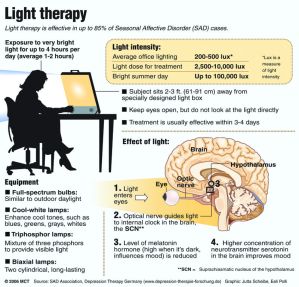It is no secret that sunlight and warmth draw people outside to enjoy the day. Even the tanning salons can help to brighten someone’s mood. Sure, a person might feel like staying inside on a rainy day but imagine being unable to function normally due to the weather.
Seasonal Affective Disorder is a condition that generally occurs in the late fall to early winter seasons. Many people call this a case of the “winter blues,” but it can be much more serious than simply missing summertime.
According to Cabrini counselor Dara Herskovits, seasonal affective disorder has become more prevalent in our society because it was only first recognized in the 1980s as a disorder.
Those who have SAD suffer from the same symptoms each year at the same time. Generally it is during the change of seasons. The reason fall/winter SAD occurs is due to the lack of sunlight a person receives.
Serotonin is an important chemical in the body and affects moods. Reduced sunlight causes a loss of serotonin which causes depression.
“As soon as my tan fades, my mood heads south,” Megan Sokolowski, sophomore communication major, said. Being a surfer and down the shore constantly, Sokolowski detests the winter.
“I hate wearing layers. There is no reason someone would want to wake up in the morning, put on 10 layers to walk outside for five minutes to class. Life is good when I can throw on a t-shirt and shorts,” Sokolowski said.
The body’s natural biological clock is also disrupted in the winter because of the lack of sunlight.
Though winter/fall SAD is much more common, people do suffer from spring/summer SAD. Some of the side effects are similar but many are drastically different. Winter/fall SAD results in weight gain and increased appetite while spring/summer SAD results in the opposite.
“I am happy in the winter and angry in the summer. Summer is break-up season and winter is cuddle season,” John Eddings, freshman pre-med/bio major, said.
The causes of spring/summer SAD are not as researched as winter/fall. Psychology professor Dr. Melissa Terlecki said little is known about spring/summer SAD. She claims to find it strange there is even such a condition because the main cause of depression is a lack of sunlight.
“Any change in environment can trigger depression,” Terlecki said.
Moving from Southern California to the seasonal east coast has been tough for freshman criminal justice major Ariel Brown.
“I already hate the weather here. It scares me. I don’t want to move and I’m lazy,” Brown said.
Most people with SAD are women and their symptoms begin typically in their mid-twenties. The number of men seeking treatment is increasing over time.
Those who suffer from SAD most times report a close relative suffering from a psychiatric condition. Most often it is severe depression or alcohol abuse.
Terlecki also said many doctors recommended tanning during the winter before it was known how bad it was.
“I am not saying go bake in the sun or tanning bed but it has been proven to help,” Terlecki said.
“I have mixed feelings about winter,” Brett Lockbaum, freshman elementary education major, said. “You can’t go outside as much and being a soccer player, it doesn’t allow me to play as much. But you can warm up in the winter better than you can cool down in the summer and I like comfy foods in winter.”
Tanning indoors is a dangerous option to help those who suffer from lack of sunlight but there are safer ways. Light boxes are available. A light box has safe rays that act as the sun.
This alternative is used like a normal lamp would be, just stronger. A person suffering from SAD should use the light box up to four hours a day.
The hours in which a person should use a light box varies due to the conditions they suffer from.
Lauren Brescia, sophomore psychology major, said her mother bought her a light box for Christmas one year even though she does not suffer from SAD.
“My mom knows my mood changes in the winter even if it is slight so she bought me a Sun Touch [light box] ,” Brescia said.
Exercising and eating right also help to boost moods and decrease the chance of having SAD. Besides using a light box, exercising and eating right help to boost moods and decrease the chance of depression.
Fall/winter SAD symptoms
- Depression
- Hopelessness
- Anxiety
- Loss of energy
- Social withdrawal
- Oversleeping
- Loss of interest in activities you once enjoyed
- Appetite changes, especially a craving for foods high in carbohydrates
- Weight gain
- Difficulty concentrating and processing information
Spring/summer SAD symptoms
- Anxiety
- Trouble sleeping (insomnia)
- Irritability
- Agitation
- Weight loss
- Poor appetite
- Increased sex drive



